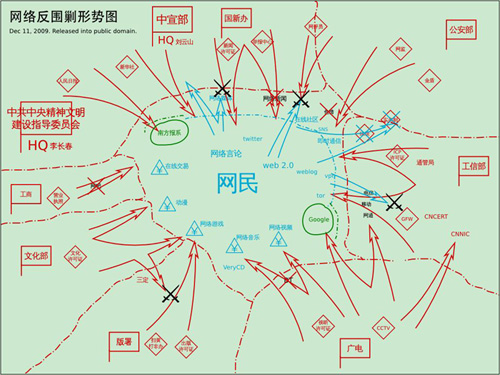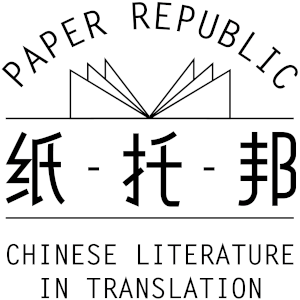
Chinese blogs, social networking sites and bulletin boards are buzzing about a humorous map of China's "Internet topography" that illustrates how China's netizens (网民, wangmin) are currently under attack from all sides. The title of the map (clever cartographer unknown) reads 网络反围剿形势图, which translates roughly as "A topographical map of resistance to [the campaign of] Internet encirclement and annihilation". Sounds clunky, I know, but it's a riff on a 1930's campaign by Chiang Kaishek and the Nationalists to encircle and wipe out communist base camps (see Wiki entry for more about the encirclement campaigns).
(Here's a larger version of the map.)
Sorry I don't have the Photoshop chops to annotate this map in English, but here are the salient details:
(1) In the center, we see China's netizens (网民) and their territory, indicated in blue. Strongholds include Google, Tor, VPN, weblogs, Web 2.0, Twitter, online speech, social networking, online music, online games, etc.
(2) On the periphery, in red, we see the territory held by various Chinese government bureaus and ministries. Red arrows indicate official encroachments; crossed swords represent recent battlegrounds; blue arrows show where China's Internet users have managed to strike back effectively.
(3) The top left is occupied by the HQ of the Spiritual Civilization Development Steering Commission (中共中央精神文明建设指导委员会), the Propaganda Department (中宣部, or 中共中央宣传部) and the State Council Information Office, SCIO (国新办, or 国务院新闻办公室), all of which are under the control of the Central Committee of the Chinese Communist Party (CCCPC).
Moving clockwise, we pass through the fiefdoms of the Ministry of Public Security (公安部); the Ministry of Industry and Information Technology (工信部, or 工业和信息化部); SARFT, the State Administration of Radio, Film and Television(广电, or 国家广播电影电视总局); GAPP, the General Administration for Press and Publications (版署, or 新闻出版总署); MOC, the Ministry of Culture (文化部) and SAIC, the State Administration for Industry and Commerce (工商, or 工商行政管理总局). Note the red arrows coming from all directions, targeting the small blue corps.
(4) Bureaucratic turf wars: the pair of crossed swords at bottom left shows where the Ministry of Culture and GAPP have clashed over jurisdiction. The red arrows emanating from bottom right illustrate SARFT encroachments into Ministry of Industry and Infotech territory.
Somebody should make a t-shirt of this.


Comments
Don't you just have to love a name like Spiritual Civilization Development Steering Commission?
Anna GC, December 15, 2009, 7:22p.m.
Interesting post - any chance to see a bigger version of the picture?
Carl Johan, December 15, 2009, 7:37p.m.
"Mainlanders have been banned from registering personal domain names, and those who already have personal websites could lose them, according to a government regulation that came into effect yesterday [Dec 14, 2009].
"The regulation states internet service providers are no longer allowed to host individually owned websites, and that only businesses with operating licences or government-authorised organisations may now have websites. The China Internet Network Information Centre, which supervises domain name registration on the mainland, said the measure stemmed from concern over widespread pornographic content on personal websites."(South China Morning Post, Dec 15, Stephen Chen)
Bruce, December 16, 2009, 12:58a.m.
Sorry Carl - I meant to add a larger image and forgot. Click the new link, in the text of my post, to see a full-page image of the map.
Cindy Carter, December 16, 2009, 12:47p.m.